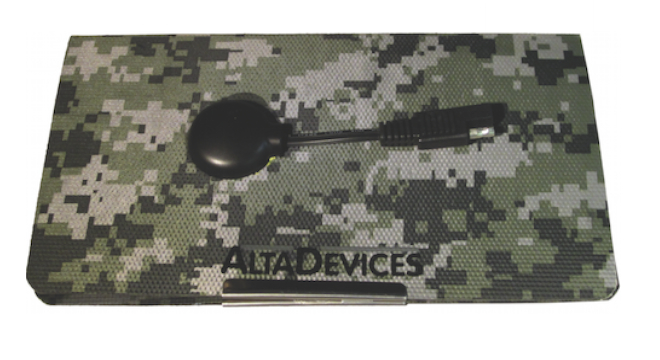Almost a year after the U.S. government first certified Alta Devices as having created the highest efficiency solar panel in existence yet, the innovative California clean energy startup on Friday unveiled its first product: A flexible, extremely lightweight and fully portable solar charging mat designed for the U.S. military, which also achieves the highest efficiency of any such solar portable charging device used by the armed forces.
Alta Devices’ new solar charging mats (PDF) come in two sizes with differing energy outputs — 10-watt and 20-watt, both which offer world record energy efficiency of 24.1 percent, an increase even from when Alta was first certified by the U.S. government in February 2012.
They’re only prototype references devices for now, though devices for mass consumptions should be coming out soon, Alta told TPM.
Already, Alta has sold a “handful” of the reference devices to the military, said Rich Kapusta, Alta Devices’ vice president of marketing, in an interview with TPM.
“What a soldier wants to be able to do is drape one of these things over their backpack,” Kapusta explained. “That way, they don’t have to stop and camp out and lay out huge solar blankets like they had to do in the past. They can literally clip these things to their backpacks and keep on marching.”
Check out a short video demo of the new Alta Devices reference charging mat below:
And here’s a photo of one mat opened, showing its exposed solar cells:

Alta’s reference charging mats are a huge improvement over the bulkier solar chargers currently in use by the military, weighing in at only 4 or 8-oz (for the 10 and 20-watt versions respectively), and the panels themselves can be bent and twisted without damage. The charging mats are about the thickness of a magazine and can be folded closed like one too, protecting the solar cells when not in use. But when they are in use, that’s where Alta really shines.
Specifically, Alta’s mats can be easily hooked up via a cable to a rechargeable lithium-ion battery carried by a soldier, which can then be used to power any sort of gadget, including consumer devices like an iPad or iPhone.
“There’s no limit to kind of rechargeable battery you can charge with this thing,” Kapusta said.
In fact, Kapusta noted that the 10-watt version of Alta’s charging mat was equivalent to the standard iPad charger that ships with Apple’s device.
“It’s no different than a wall plug, except instead of plugging something into the wall, you’re plugging it into the Sun,” Kapusta explained.
The major technological advance behind Alta’s record-setting ultra-flexible solar panels is a material called gallium arsenide, a byproduct of aluminum smelting combined with arsenic, which turns out to be perfect for solar panels because it can withstand high temperatures and be sliced extremely thin — one micron thick — or about the thickness of a human hair in Alta’s case. Alta has filed 77 patents on its advances.
Alta’s new invention clearly fits in well with the U.S. military’s continued efforts to power more operations with clean energy, but the consumer electronic industry is extremely interested in what Alta has to offer for consumer mobile devices like tablets and smartphones, too.
“We have been approached by all the major consumer electronics guys,” Kapusta said.
In fact, Alta’s reference military charging mats are merely a vehicle for the company to pursue a much grander ambition: Pure solar-powered mobile energy for every major use case — consumer devices, autos, aircraft, anything that’s not fixed or stationary (although the company plans to expand to that market as well, once its already conquered the mobile charging market.)
“We are strongly positioning this technology into applications that have some element of mobility,” Kapusta explained. “Anything that can be worn, carried or moves.”
That’s why Alta unveiled the reference devices without any specific timeline for full commercial availability: It wants potential customers and business partners to know that there will be many more diverse devices in the future. Alta on Friday also launched a redesigned website, logo and released briefs (PDF) on its technology.
“The company is transitioning from its stealthy research and development mode to making and selling commercial products,” Kapusta said.
Alta was founded in 2008 by professors from Caltech and Berkeley and has since gone on to raise a total of $120 million in venture and corporate funding. Alta, which counts 80 employees, is currently pursuing a small fundraising round that will further add to that total. The company, headquartered in Sunnyvale, Ca., has only started to turn on its revenue stream with the sale of its first reference charging mats to the military, but expects more revenue as it ramps up into 2013.









